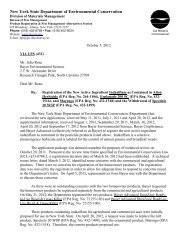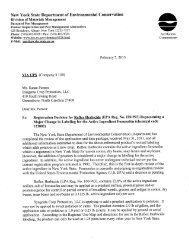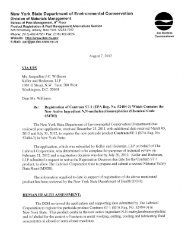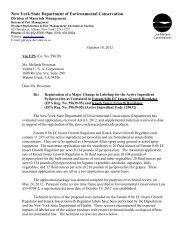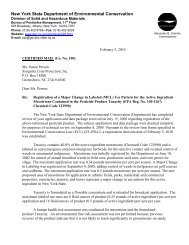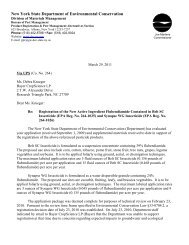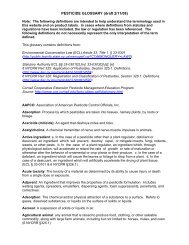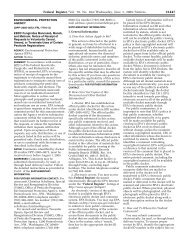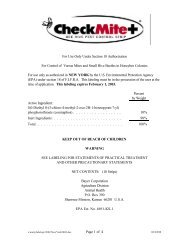New York State Department of Environmental ... - PMEP Home
New York State Department of Environmental ... - PMEP Home
New York State Department of Environmental ... - PMEP Home
Create successful ePaper yourself
Turn your PDF publications into a flip-book with our unique Google optimized e-Paper software.
<strong>New</strong> <strong>York</strong> <strong>State</strong> <strong>Department</strong> <strong>of</strong> <strong>Environmental</strong> Conservation<br />
Division <strong>of</strong> Materials Management<br />
Bureau <strong>of</strong> Pest Management<br />
Product Registration & Pest Management Alternatives Section<br />
625 Broadway, Albany, <strong>New</strong> <strong>York</strong> 12233-7257<br />
Phone: (518) 402-8768 • Fax: (518) 402-9024<br />
Website: www.dec.ny.gov<br />
E-mail: ppr@gw.dec.state.ny.us<br />
Via UPS (Co. No. 352)<br />
Ms. Annette Marine<br />
E.I. du Pont de Nemours and Co., Inc.<br />
Stine-Haskell Research Center, S300/423<br />
<strong>New</strong>ark, DE 19714<br />
Dear Ms. Marine:<br />
November 5, 2012<br />
Joe Martens<br />
Commissioner<br />
Re: Registration <strong>of</strong> a Major Change in Labeling for the Active Ingredient<br />
Chlorantraniliprole as Contained in DuPont Altriset Termiticide (EPA Reg. No.<br />
352-829)<br />
The <strong>New</strong> <strong>York</strong> <strong>State</strong> <strong>Department</strong> <strong>of</strong> <strong>Environmental</strong> Conservation (<strong>Department</strong>) has evaluated<br />
your application (received April 7, 2011) and supplemental materials received to date in support <strong>of</strong> the<br />
registration <strong>of</strong> the above-referenced pesticide product.<br />
Chlorantraniliprole was initially registered by the <strong>Department</strong> on August 4, 2009 for use on<br />
numerous agricultural crops with a maximum use rate <strong>of</strong> 0.2 pounds <strong>of</strong> chlorantraniliprole per acre per<br />
year. Registration for use on turf and ornamentals followed on November 27, 2009. The approved use<br />
rates for turf and ornamental uses are 0.2 pounds <strong>of</strong> chlorantraniliprole per acre per application and 0.5<br />
pounds <strong>of</strong> chlorantraniliprole per acre per year. Numerous conditions were placed on the registrations <strong>of</strong><br />
chlorantraniliprole-containing products as part <strong>of</strong> the negotiated registration decision with E.I. du Pont<br />
de Nemours and Co., Inc (DuPont). These conditions included classification <strong>of</strong> all products as<br />
Restricted Use Pesticides in <strong>New</strong> <strong>York</strong> <strong>State</strong>, prohibition from sale, distribution, and use in Nassau,<br />
Suffolk, Kings, and Queens counties <strong>of</strong> <strong>New</strong> <strong>York</strong> <strong>State</strong>, buffer zones to aquatic areas <strong>of</strong> 25 feet (greens<br />
and tee boxes), 50 feet (fairways), and 100 feet (all other use sites), and prohibition <strong>of</strong> aerial application.<br />
The current major change in labeling application for DuPont Altriset Termiticide (Altriset)<br />
proposes application for remedial and preventative termite control, including control <strong>of</strong> subterranean<br />
termites. Altriset contains 18.4% <strong>of</strong> the active ingredient chlorantraniliprole and is a 100% repack <strong>of</strong><br />
DuPont Coragen Insecticide, which was registered by the <strong>Department</strong> on August 4, 2009. Application is<br />
limited to individuals/firms registered by the state to apply termiticide products.
Ms. Annette Marine 2.<br />
The application was deemed complete for purposes <strong>of</strong> technical review on June 6, 2011.<br />
Pursuant to the review time frame specified in <strong>Environmental</strong> Conservation Law §33-0704.2, a<br />
registration decision date <strong>of</strong> November 3, 2011 was established. Technical reviews <strong>of</strong> the proposed uses<br />
included on the DuPont Altriset Termiticide label have been performed by the <strong>Department</strong> and the<br />
<strong>New</strong> <strong>York</strong> <strong>State</strong> <strong>Department</strong> <strong>of</strong> Health. These reviews encompassed the expected impacts <strong>of</strong> labeled use<br />
<strong>of</strong> the subject products with respect to human health, environmental fate, and ecological effects. On<br />
October 6, 2011, the <strong>Department</strong> sent a “Technical Issues” letter to DuPont describing unmitigated<br />
concerns with respect to the expected impacts <strong>of</strong> the use <strong>of</strong> Altriset on the water resources in <strong>New</strong> <strong>York</strong><br />
<strong>State</strong>. A meeting was held between <strong>Department</strong> staff and DuPont representatives on December 2, 2011.<br />
Subsequent to this meeting, DuPont submitted additional information in support <strong>of</strong> registration. In<br />
addition, DuPont has added language to the Altriset label prohibiting the use <strong>of</strong> the product in Nassau<br />
and Suffolk counties. The additional information and label modifications provided by DuPont have<br />
sufficiently mitigated the <strong>Department</strong>’s concerns. The technical reviews are shown below.<br />
HUMAN HEALTH ASSESSMENT:<br />
The following technical review was produced by staff within the Bureau <strong>of</strong> Toxic Substance<br />
Assessment at the <strong>New</strong> <strong>York</strong> <strong>State</strong> <strong>Department</strong> <strong>of</strong> Health (DOH):<br />
Neither chlorantraniliprole nor the formulated product DuPont Altriset (Coragen) was very<br />
toxic in acute oral, dermal or inhalation exposure studies in laboratory animals. In addition, neither the<br />
active ingredient nor the formulated product was irritating to skin and eyes (tested on rabbits) or skin<br />
sensitizers (tested on guinea pigs).<br />
The DOH previously reviewed the toxicological properties <strong>of</strong> the active ingredient<br />
chlorantraniliprole in the pesticide products DuPont Coragen Insect Control, DuPont Altacor Insect<br />
Control, and DuPont Acelepryn Insecticide and Grubex I. In the previous reviews DOH indicated that<br />
the active ingredient was neither carcinogenic, genotoxic, neurotoxic, teratogenic nor did it cause<br />
reproductive effects. Chlorantraniliprole was shown to cause some effects in only one study <strong>of</strong> many<br />
studies in the toxicological database; the presence <strong>of</strong> eosinophilic foci accompanied by hepatocellular<br />
hypertrophy and increased liver weight in male mice in a chronic toxicity/oncogenicity feeding study at<br />
a dose <strong>of</strong> 935 milligrams chlorantraniliprole per kilogram bodyweight per day (mg/kg/day); the noobserved-effect-level<br />
(NOEL) was 158 mg/kg/day. The U.S. <strong>Environmental</strong> Protection Agency (U.S.<br />
EPA) derived a chronic reference dose (RfD) <strong>of</strong> 1.58 mg/kg/day for chlorantraniliprole using this NOEL<br />
and an uncertainty factor <strong>of</strong> 100. In addition, the U.S. EPA classified chlorantraniliprole as “not likely<br />
to be carcinogenic to humans” based on a lack <strong>of</strong> treatment related tumors in chronic<br />
toxicity/oncogenicity feeding studies in laboratory animals and negative results in a number <strong>of</strong><br />
genotoxicity studies. A current search <strong>of</strong> the toxicological literature did not find any significant new<br />
information on the toxicity <strong>of</strong> chlorantraniliprole.<br />
The U.S. EPA did not conduct occupational or residential risk assessments for the use <strong>of</strong><br />
chlorantraniliprole as a termiticide. A risk assessment for worker exposure to this active ingredient was<br />
not required because the U.S. EPA did not identify toxicity endpoints for short-/intermediate-term<br />
dermal and inhalation exposures. However, the U.S. EPA identified a potential long-term toxicity<br />
endpoint for residential post-application inhalation exposure to chlorantraniliprole from application to a<br />
home’s perimeter. The U.S. EPA concluded that post-application inhalation risks to residents, including
Ms. Annette Marine 3.<br />
children, would be negligible given the low toxicity <strong>of</strong> chlorantraniliprole and extremely low exposure<br />
estimates based on the vapor pressure <strong>of</strong> chlorantraniliprole (2.1 x 10 -13 millimeters <strong>of</strong> mercury at 25<br />
degrees Celsius) and the Ideal Gas Law.<br />
There are no chemical specific federal or <strong>New</strong> <strong>York</strong> <strong>State</strong> drinking water/groundwater standards<br />
for chlorantraniliprole. Based on its chemical structure, chlorantraniliprole falls under the 50 microgram<br />
per liter (μg/L) general <strong>New</strong> <strong>York</strong> <strong>State</strong> drinking water standard for an “unspecified organic<br />
contaminant” (10 NYCRR Part 5, Public Water Systems).<br />
In the previous review <strong>of</strong> DuPont Coragen Insect Control, DuPont Altacor Insect Control, and<br />
DuPont Acelepryn Insecticide, DOH expressed some concern about the leaching potential <strong>of</strong><br />
chlorantraniliprole and its degradates to contaminate groundwater and drinking water. The<br />
environmental fate data indicate adsorption coefficients (Koc) in various soil types between 153 and 509<br />
and soil half-lives ranging from 228 to 924 days. Consequently, chlorantraniliprole may have high<br />
mobility through some soils and extended use is expected to cause accumulation <strong>of</strong> residues in soil from<br />
year to year. These concerns were mitigated in the previously registered products by prohibiting use in<br />
vulnerable areas <strong>of</strong> the state (Nassau, Suffolk, Kings, and Queens Counties) and restrictions on<br />
applications near bodies <strong>of</strong> water.<br />
The available information on chlorantraniliprole and the formulated product DuPont Altriset<br />
Termiticide indicates that they are not very acutely toxic in laboratory animal studies.<br />
Chlorantraniliprole was not carcinogenic, genotoxic, neurotoxic, teratogenic and it did not cause<br />
reproductive effects. Although data from the chronic feeding/oncogenicity study in mice indicated some<br />
liver effects, the expected exposure from the labeled uses <strong>of</strong> DuPont Altriset Termiticide should not pose<br />
a significant risk to workers or the general public. While the large quantities <strong>of</strong> product that are<br />
sometimes applied near house foundations during termiticide applications can pose a concern for indoor<br />
air impacts, chlorantraniliprole has a low vapor pressure and the formulated Altriset end product does<br />
not contain a volatile organic solvent system. The DuPont Altriset Termiticide label indicates that<br />
individuals who use this product must be licensed by the state to apply termiticides, which indicates that<br />
it would be classified as a “Restricted Use Pesticide” if registered in the state.<br />
Given the above, the <strong>New</strong> <strong>York</strong> <strong>State</strong> <strong>Department</strong> <strong>of</strong> Health does not object to the registration <strong>of</strong><br />
DuPont Altriset Termiticide in the state on the basis <strong>of</strong> direct health risks from worker and residential<br />
post-application exposures.<br />
ECOLOGICAL EFFECTS ASSESSMENT:<br />
The application was reviewed by staff within the <strong>Department</strong>’s Division <strong>of</strong> Fish, Wildlife &<br />
Marine Resources’ Bureau <strong>of</strong> Habitat (BOH). BOH staff stated that fish and wildlife are unlikely to<br />
be exposed due <strong>of</strong> the manner <strong>of</strong> application <strong>of</strong> Altriset in and around structures. Therefore, the<br />
Bureau <strong>of</strong> Habitat does not object to registration <strong>of</strong> the Altriset product on the basis <strong>of</strong> expected<br />
impacts to non-target organisms.
Ms. Annette Marine 4.<br />
ENVIRONMENTAL FATE ASSESSMENT:<br />
The following technical review was produced by the <strong>Department</strong>’s Engineering Geology<br />
staff within the Bureau <strong>of</strong> Pest Management:<br />
The Altriset label indicates a use rate <strong>of</strong> 0.05% for all use sites and application methods. The<br />
product is applied via trenching, rodding, sub-slab injections, and treated backfill, all at four gallons per<br />
ten linear feet per foot <strong>of</strong> depth to top <strong>of</strong> footing. Backfill is allowed at one gallon per one cubic foot <strong>of</strong><br />
soil, and horizontal applications at one to 1.5 gallons per ten square feet. Non- structural applications<br />
are allowed at one gallon per ten square feet, or four gallons per ten linear feet. One gallon <strong>of</strong> Altriset<br />
contains 1.67 lb ai, and a 0.05% solution contains 0.0008 lb ai/gallon. The label does not indicate a<br />
retreatment rate, so one year is assumed. The label indicates that if the depth to the footer is greater than<br />
four feet, the treatment must extend to a minimum depth <strong>of</strong> four feet.<br />
The review on this active ingredient was done as part <strong>of</strong> a global work share by the U.S. EPA,<br />
Canada, Australia, United Kingdom and Ireland, thus there are no Data Evaluation Record reports.<br />
Solubility: Chlorantraniliprole has a solubility at pH 7 <strong>of</strong> 1.023 mg/L.<br />
Hydrolysis: Chlorantraniliprole is stable to hydrolysis in pH 5 and 7 buffer solutions. In pH 9 solution,<br />
it undergoes rapid hydrolysis. The major degradation product is IN-EQW78.<br />
Aqueous Photolysis: Chlorantraniliprole has a half-life <strong>of</strong> 0.37 days in a pH 7 buffer solution and 0.31<br />
days in a natural water.<br />
Soil Photolysis: In a water/sediment system, chlorantraniliprole had photodegradation half-lives <strong>of</strong> 22<br />
days in a loamy sand sediment system and 0.9 days in a sandy loam sediment system. Major<br />
degradation products at pH 7 were IN-LBA22 at 52.1%, IN-LBA24 at 90.2% and IN-LBA23 at 40%.<br />
Aerobic Soil Metabolism: Chlorantraniliprole had half-lives <strong>of</strong> 228-924 days at 25 o C. No major<br />
degradation products were found at 25 o C. Staff consulted the global work share document, and using<br />
additional information from DuPont, were able to determine that the Marietta sandy loam had a grain<br />
size distribution closest to the Riverhead sandy loam, with a half-life <strong>of</strong> 888.6 days.<br />
The EPA=s Ecological Risk Assessment did not mention degradates, but the global work share document<br />
indicated that IN-EQW78 was found at greater than 10% in the studies.<br />
Aerobic Aquatic Metabolism: In a sand and loam sediment water system, chlorantraniliprole was<br />
persistent 125-231 days. Major degradation product IN-EQW78 was found at 30.2%.<br />
Anaerobic Aquatic Metabolism: The half-life in a flooded loam soil (pH 7.0, %OC 0.87) was 208<br />
days.<br />
Adsorption/Desorption Studies: In a loamy sand from Spain (pH 7.7, % OC 0.5), the Koc was 153; in a<br />
silty clay loam (pH 5.7, % OC 1.7) the Koc was 509; in a sandy loam from Mississippi (pH 6.7, % OC<br />
0.6) the Koc was 272, in a loamy sand from Georgia (pH 5.9, % OC 0.2) the Koc was 526 and in a loam
Ms. Annette Marine 5.<br />
soil from Italy (pH 7.7, % OC 1.3) it was 180. The EPA=s Ecological Risk Assessment did not mention<br />
degradates, but the global work share document indicated that IN-EQW78 had a Koc <strong>of</strong> 22,196 in a<br />
loamy sand soil (pH 6.7, %OC 0.5).<br />
Field Dissipation: Field studies done in Minnesota (loam, pH 6.7, % OM 4.3) and Prince Edward<br />
Island, Canada (sandy loam pH 5.96 and % OM 3.7) showed half-lives ranging from 210 to 274 days<br />
with biphasic degradation kinetics. No major metabolites were noted. There were no detections <strong>of</strong> the<br />
parent compound below 12 inches.<br />
Radiolabeled field studies done in California and Texas showed half-lives ranging from 181-222 days.<br />
In the Texas study, the major degradate IN-EQW78 was found at 42%. In the California study, it was<br />
found at 29%.<br />
Nonradiolabeled field studies had half-lives <strong>of</strong> 52 days in California (IN-EQW78 found at 21%), 206<br />
days in Texas (IN-EQW78 found at 20%) (pH 8.2, % OM 1.1), 697 days in <strong>New</strong> Jersey (pH 6.6, % OM<br />
1.7) and 1130 days in Georgia (IN-EQW78 found at 12%) (pH 6.5, % OM 0.6).<br />
Degradates: IN-EQW78 had a half-life <strong>of</strong> 651 days in a loamy sand soil. IN-EQW78 had a Koc <strong>of</strong><br />
22196 in a loamy sand soil (pH 6.7, %OC 0.5).<br />
Computer Modeling <strong>of</strong> Chlorantraniliprole: For modeling purposes, staff assumed four houses per<br />
acre, and each house is 24 X 40 feet, making 128 linear feet <strong>of</strong> trench per house four feet deep.<br />
Application Koc T ½ Application Projections at Accumulation?<br />
Frequency<br />
rate 10 years<br />
Application<br />
Every Year<br />
526 888 days 0.66 lb ai/a* 15 ppb Accumulates<br />
Application<br />
Once Every<br />
Five Years<br />
526 888 days 0.66 lb ai/a* 2.5-3.5 ppb Accumulates<br />
*0.0008 lb/gallon X 4 gallons/10 linear feet X 128 feet long X 4 feet <strong>of</strong> depth X 4 houses<br />
Modeling the degradate IN-EQW78 using a half-life <strong>of</strong> 651 days, a Koc <strong>of</strong> 22,196, and assuming a high<br />
degradation rate <strong>of</strong> 40% the model predicted no leaching <strong>of</strong> the degradate.<br />
Label <strong>State</strong>ments: The following statements appear on the label: “Ground Water Advisory - This<br />
chemical has properties and characteristics associated with chemicals detected in ground water. The use<br />
<strong>of</strong> this chemical in areas where soils are permeable, particularly where the water table is shallow, may<br />
result in ground water contamination.”<br />
EPA Comments: Chlorantraniliprole is persistent and mobile in terrestrial and aquatic environments.<br />
Extended chlorantraniliprole use is expected to cause accumulation <strong>of</strong> residues in soil from year to year.<br />
Major routes <strong>of</strong> dissipation are expected to be alkaline-catalyzed hydrolysis, photodegradation in water,<br />
leaching and run<strong>of</strong>f.
Ms. Annette Marine 6.<br />
Review <strong>of</strong> Additional Information Submitted by DuPont: A supplemental technical review was<br />
performed on two field dissipation studies submitted by DuPont:<br />
Field Dissipation <strong>of</strong> Chlorantraniliprole on Bare Soil and in the Presence <strong>of</strong> a Leafy Vegetable in<br />
Atwater, California, Under Multiple Water Application Regimes (February 18, 2011):<br />
Chlorantraniliprole was applied at 0.2 lb ai/a, the maximum seasonal use rate for vegetable crops<br />
to a loamy sand soil with >80% sand, a pH <strong>of</strong> 6.7 and 0.6% organic matter. Two bare ground<br />
plots and one leafy vegetable crop plot were utilized. Irrigation was applied at 125% or 160% <strong>of</strong><br />
moisture needs to ensure sufficient water to move into the lower depths <strong>of</strong> the soil column.<br />
Results indicated that mobility was not affected by the increase in irrigation. Soil and vegetation<br />
samples were analyzed for residues <strong>of</strong> the parent and degradates IN-EQW78 and IN-ECD73.<br />
Field Dissipation <strong>of</strong> Chlorantraniliprole Insecticide on Bare Soil in California Valley Site, Under<br />
Multiple Water Application Regimes (February 21, 2011): Chlorantraniliprole was applied at 0.2<br />
lb ai/a, the maximum seasonal use rate for vegetable crop to a loamy sand soil with >80% sand, a<br />
pH <strong>of</strong> 6.4 and 0.6% organic matter. Two bare ground plots were utilized. Irrigation was applied<br />
at 125% or 160% <strong>of</strong> moisture needs to ensure sufficient water to move into the lower depths <strong>of</strong> the<br />
soil column. Results indicated that mobility was not affected by the increase in irrigation. Soil<br />
samples were analyzed for residues <strong>of</strong> the parent and degradates IN-EQW78 and IN-ECD73.<br />
The data results for both studies indicated that chlorantraniliprole, applied at 0.2 lb ai/a/yr, was<br />
persistent throughout the study. The parent moved slowly down the soil column, with most <strong>of</strong> the<br />
applied mass in the top 6 inches <strong>of</strong> soil. Detections (above the LOQ) were found at low ppb levels<br />
by the end <strong>of</strong> the study down to the 28-36 and the 36-45 inch depth. Degradate IN-EQW78 was<br />
found with concentrations highest in the upper layers, as would be expected by the high Koc for<br />
this degradate, decreasing over time. Degradate IN-ECD73 was detected at low ppb levels in the<br />
upper six inches.<br />
Summary: The terrestrial field dissipation studies indicated that the parent is persistent, moving<br />
slowly down through the soil column over the year and a half <strong>of</strong> the studies. Discussions with the<br />
registrant indicated that the product will likely need to be applied approximately every seven<br />
years, which is verified by the study. LEACHP modeling at four houses per acre, treated every<br />
five years (rather than every year) projects leaching between 2.5 and 3.5 ppb. Modeling supports<br />
the label statements that use <strong>of</strong> the product as labeled could negatively impact groundwater when<br />
used in vulnerable, sandy areas. With the inclusion <strong>of</strong> label language prohibiting the application<br />
<strong>of</strong> the Altriset product in Nassau and Suffolk Counties, Engineering Geology staff does not object<br />
to the registration <strong>of</strong> this product as labeled.<br />
REGISTRATION DECISION<br />
DuPont has added a label statement prohibiting the sale, distribution, and use <strong>of</strong> Altriset in<br />
Nassau and Suffolk counties <strong>of</strong> <strong>New</strong> <strong>York</strong> <strong>State</strong>. This condition has sufficiently mitigated the concerns<br />
expressed during the technical review <strong>of</strong> the major change in labeling application for chlorantraniliprole.<br />
Therefore, the <strong>Department</strong> has registered DuPont Altriset Termiticide (EPA Reg. No. 352-829) for<br />
use in <strong>New</strong> <strong>York</strong> <strong>State</strong>. Enclosed for your record are copies <strong>of</strong> the Certificate <strong>of</strong> Pesticide Registration
Ms. Annette Marine 7.<br />
and stamped “Accepted for Registration” label.<br />
Please note the yes under the “restriction” column on the enclosed Certificate <strong>of</strong> Pesticide<br />
Registration and the “Classified for Restricted Use in <strong>New</strong> <strong>York</strong> <strong>State</strong>” stamp on the enclosed product<br />
label. As such, the product is restricted in its purchase, distribution, sale, use and possession in<br />
<strong>New</strong> <strong>York</strong> <strong>State</strong>. Furthermore, the product may only be purchased and used by a certified applicator in<br />
<strong>New</strong> <strong>York</strong> <strong>State</strong>.<br />
The <strong>New</strong> <strong>York</strong> <strong>State</strong> <strong>Department</strong> <strong>of</strong> <strong>Environmental</strong> Conservation Regulations 6 NYCRR<br />
326.3(a) state: “It shall be unlawful for any person to distribute, sell, <strong>of</strong>fer for sale, purchase for the<br />
purpose <strong>of</strong> resale, or possess for the purpose <strong>of</strong> resale, any restricted pesticide unless said person shall<br />
have applied for, and been issued a commercial permit.”<br />
Should you require information to obtain a commercial permit, please contact the Pesticide<br />
Reporting and Certification Section, at 518-402-8748.<br />
The Pesticide Reporting Law within <strong>Environmental</strong> Conservation Law Article 33 Title 12<br />
requires all certified commercial pesticide applicators to report information annually to the <strong>Department</strong><br />
regarding each pesticide application they make. Commercial pesticide retailers are required to<br />
report all sales <strong>of</strong> restricted pesticide products and sales <strong>of</strong> general use pesticide products to<br />
private applicators for use in agricultural crop production. If no sales are made within <strong>New</strong> <strong>York</strong><br />
<strong>State</strong>, a report must be filed with the <strong>Department</strong> indicating this is the case. If you need information<br />
relating to the Pesticide Reporting Law, or annual report forms, please visit the <strong>Department</strong>’s website at<br />
http://www.dec.ny.gov/chemical/27506.html or call 518-402-8748.<br />
Please note that a proposal by DuPont or any other registrant to register a product that contains<br />
chlorantraniliprole, and whose labeled uses are likely to increase the potential for significant impact on<br />
humans, nontarget organisms, or the environment, would constitute a major change in labeling. Such an<br />
application must be accompanied by a new application fee and meet the requirements listed in Appendix<br />
1.B. <strong>of</strong> “<strong>New</strong> <strong>York</strong> <strong>State</strong> Pesticide Product Registration Procedures” (April 2009). Such information, as<br />
well as forms, can be accessed at our website as listed in our letterhead.<br />
Please contact Shaun Peterson, <strong>of</strong> the Pesticide Product Registration Section, at 518-402-8768, if<br />
you have any questions regarding this letter.<br />
Enclosures<br />
Sincerely,<br />
Scott Menrath<br />
Scott Menrath, P.E.<br />
Director<br />
Bureau <strong>of</strong> Pest Management



